| S.40 | |
|---|---|
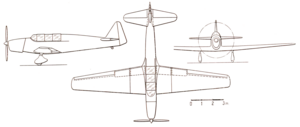 | |
| 3-views of the SABCA S.40E | |
| Role | Trainer |
| National origin | Belgium |
| Manufacturer | SABCA |
| First flight | 1939 |
The SABCA S.40 was a military trainer aircraft built in Belgium in 1939. [1]
| S.40 | |
|---|---|
 | |
| 3-views of the SABCA S.40E | |
| Role | Trainer |
| National origin | Belgium |
| Manufacturer | SABCA |
| First flight | 1939 |
The SABCA S.40 was a military trainer aircraft built in Belgium in 1939. [1]
The S.40 was a graceful, low-wing cantilever monoplane of conventional design with fixed, tailwheel undercarriage. The pilot and instructor sat in tandem cockpits, enclosed by sliding canopies. [2] A single engine driving a two-blade propeller was mounted in the nose. The main undercarriage units were fully independent, mounted under the wings, and enclosed in spats. A small number were built for the Belgian military before the German invasion in 1940. [2]
General characteristics
Performance
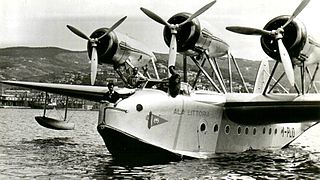
The Macchi M.C.100 was an Italian commercial flying boat designed and built by Macchi.
The Maestranza Central de Aviación HF XX-02 was a military trainer aircraft developed in Chile in the 1950s.

The Lorraine-Hanriot LH.10 was a family of training monoplanes built in France in the early 1930s, the most widely produced and well-known member of which was the LH.16, later known simply as the Hanriot H.16. It was a conventional parasol-wing monoplane with fixed tailskid undercarriage, the main units of which were mounted on outriggers attached to the wing struts. The pilot and instructor sat in tandem open cockpits.

The Hanriot H.170, H.180, and H.190 were a family of light utility aircraft produced in France in the 1930s. All introduced in 1934, they appeared side by side at the Paris Air Show that year, the model numbers distinguishing between versions powered by Salmson, Renault, and Régnier engines respectively.
The Hopfner HV-6/28 was a small airliner built in Austria in the late 1920s for Swiss use. Unrelated to Hopfner's other airliners of the period, the HV-6/28 was a conventional, high-wing, strut-braced monoplane with a fully enclosed cabin. The main units of the fixed tailskid undercarriage were divided. The single example built was flown by Aero St. Gallen between 1929 and 1931, and then scrapped.
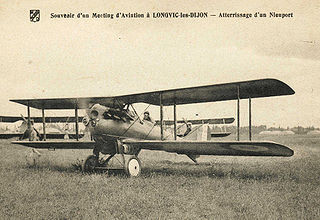
The Nieuport-Delage NiD.29 was a French single-seat biplane fighter designed and built by Nieuport-Delage for the French Air Force.

The Morane-Saulnier MS.129 and its derivatives in the MS.130 series were a family of military trainer aircraft produced in France in the 1920s. They were conventional, parasol-wing monoplanes with open cockpits in tandem and fixed tailskid undercarriage. The initial version, the MS.129, was produced in small numbers for the Romanian Air Force and civil users, but the major production version was the MS.130, which equipped the French Navy and a number of foreign air arms.

The Morane-Saulnier MS.570 was a civil utility aircraft produced in small numbers in France in the late 1940s.
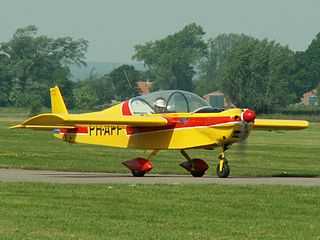
The Pottier P.70 was a single-seat, single-engine sport aircraft developed in France in the 1970s and marketed for homebuilding. It was a mid-wing cantilever monoplane of conventional design with an enclosed cockpit. Originally designed with fixed, tricycle undercarriage, the plans were later revised to offer a fixed, tailwheel option. Construction throughout was of metal. A two-seat, tandem version was developed as the P.170.

The Praga BH-41, later redesignated E-41, was a military advanced trainer aircraft produced in Czechoslovakia during the 1930s.

The Rumpler B.I was a military reconnaissance aircraft produced in Germany during World War I.

The Rumpler G.I was a bomber aircraft produced in Germany during World War I, together with refined versions known as the G.II and G.III.

The SABCA S.2 was an airliner built in Belgium in 1926.
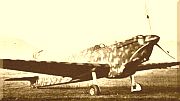
The Caproni Ca.335 Maestrale (Mistral) was an Italian single-engined two-seat fighter-bomber/reconnaissance aircraft of the 1930s.
The SECAT RG-75 was a light utility monoplane built in France shortly after World War II. It was a conventional cabin monoplane with two seats side-by-side. The wing was mounted high and was of fully cantilever design. The conventional undercarriage consisted of two fixed, divided main units plus a fixed tailskid. Power was supplied by a tractor-mounted piston engine that drove a two-bladed propeller. Construction was of wood throughout, covered in plywood.

The SPCA 40T, also designated the SPCA VII, was a mailplane built in France in the late 1920s.
The Stampe et Vertongen RSV.22 was a training biplane produced in Belgium in the 1920s.
The Stampe et Vertongen RSV.28/180 Type III, also known as the RSV.28-PSV was a military trainer aircraft built in Belgium to teach instrument-flying techniques. It was a response to a 1929 order from the Belgian Air Force, whose instrument-flying certification required a flight around a 100-kilometre (62 mi) triangular course and return to a point less than 5 kilometres (3.1 mi) from the start, using instruments only.

The Stampe et Vertongen SV.5 Tornado was a military trainer aircraft designed and built in Belgium in the 1930s. It saw service with the Belgian Air Force and Latvian Air Force, and Latvian firm VEF purchased a production license, although it is uncertain whether it built any examples.

The I.Ae.32 Chingolo was a civil trainer, touring and aerobatic aircraft developed in Argentina in the 1940s. It was designed by Sandro Gorissenso and developed by the Instituto Aerotécnico for manufacture by the company “Mario Vicente Construcciones Aeronáuticas” in Córdoba Province as an initiative under President Juan Perón's first five year plan.